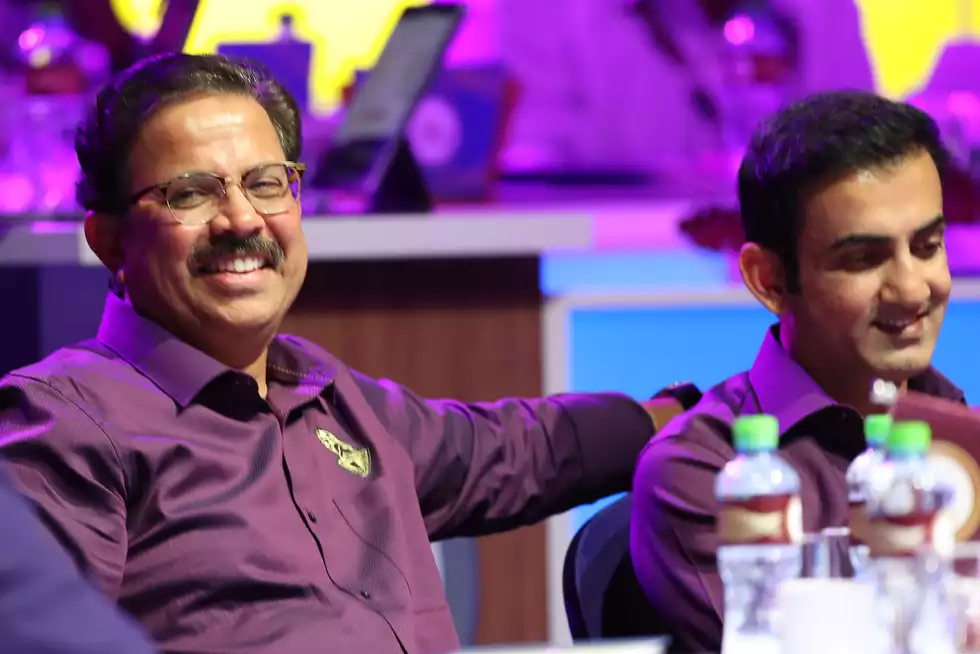

After the day's proceedings, Sanjiv Goenka and Kumar Sangakkara engaged in sagacious and engrossing deliberations over Indian Premier League (IPL) salaries breaching the glass ceiling. "Mini auctions are notorious for that. If you have a high purse and no supply and specific targets, it can happen, and it did happen today," remarked the Rajasthan Royals coach rather succinctly. "We knew it was going to be breached, but not by us."
Goenka was more forthright. "These barriers were getting breached each season. Who knows the 25 crore barrier may get breached next time around." Goenka and Sangakkara were addressing the hefty salaries for the Australian pace twins - Mitchell Starc and Pat Cummins - who breached the INR 20 crore mark in the league.
It was a significant step forward for the IPL considering that INR 20 crore was the total salary cap in the inaugural year of the league - it was $ 5 million in 2008 with the exchange rate being INR 40. In the 15 years since its inception, the IPL has come a long way. "The salary cap has gone up significantly since the first year. Naturally, the player fee is bound to go up," explained Venky Mysore, the CEO, and MD of Knight Riders, who broke the bank to buy Starc for INR 24.75 crore. If Starc was the star of the auction, Mysore was the newsmaker. And he referred to the current salary cap of INR 100 crore.
Starc sure was the costliest buy, but the rest - KS Bharat (INR 50 lakh), Chetan Sakariya (INR 50 lakh), Angkrish Raghuvanshi (INR 20 lakh), Ramandeep Singh (INR 20 lakh), Sherfane Rutherford (INR 1.5 cr), Manish Pandey (INR 50 lakh), Mujeeb Rahman (INR 2 cr), Gus Atkinson (INR 1 cr), and Sakib Hussain (INR 20 lakh) - were bought at their base price. "Teams decide to slice it differently. What you've paid to somebody up, down, and whatnot is a matter of perspective. Ultimately, we're all spending the same amount of money," the KKR official elaborated on the rationale of Starc's price.
Knight Riders were engaged in an intense bidding war with Gujarat Titans, who had come to the auction table with the maximum purse (INR 38.15 crore). KKR's balance at the start of the day was much less (32.7). As it turned out, when the Starc name came up for auction, both were on equal footing - KKR had INR 31.70 crore, and GT's purse was INR 31.85 crore. This was mainly because KKR missed out on a few players in the beginning, having been outbid by Rajasthan Royals and Punjab Kings for Rovman Powell and Chris Woakes, respectively, while Titans rushed for Azmatullah Omarzai (INR 50 lakh) and Umesh Yadav (INR 5.8 cr). It was clear that the Titans wanted Starc and went up to INR 24.5 crore before Knight Riders snapped up the Aussie for INR 25 lakh more.
"We knew Gujarat would be our competition. They had a lot more money than us but they made a couple of purchases and it equalized the purse virtually. It came down to almost level. It's difficult to say how far we would have gone. In the end, maybe we made one more bid than GT expected, and they made one bid less than we expected.
"Those are the auction dynamics, that's how they work. It could have gone the other way. Had they continued, we would have had to stop it at some point. How far you go depends on how much other work is left to do, how many slots you have, what players you want, and how much money you want to fill those gaps," Mysore analysed.
So what if one piece of the pie was quite significant is the logic of the KKR management. The Starc price of INR 24.75 crore is 25 per cent of the total purse (INR 100 crore) but their attitude towards auction was very simple. There is a salary cap and that is INR 100 crore. All 10 teams have the same. When everyone was done with the auction and walked away, everyone had spent INR 100 crore - not much more and not much less. The beauty about it all, as Mysore said, was that they got the player they wanted.
Luck played a part for the Knight Riders, but there was also the factor of intent and determination. In hindsight, not securing Powell and Woakes actually helped the Knight Riders to reserve funds for Starc, while the Titans, who remained silent for most of the beginning, might have done better by waiting longer for their first purchase. After the long bidding battle, Mysore and Vikram Solanki hugged each other but the Titans head was visibly disappointed. Despite arriving at the auction with maximum money, the Titans could not acquire the player they had yearned for.
| Share | Tweet |